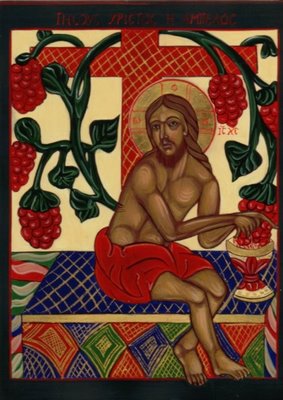Icons-Interfaith, paintings by G.E.
Welcome to Icons Interfaith - a blog dedicated to Christian Icons, but likewise to Icons from other traditions.
Friday, December 23, 2011
Friday, June 04, 2010
Jesus and Peter

This is an icon on the story of Jesus walking on the sea and Peter trying to do the same.
The text according to Mt 14:22-14:33: http://www.biblegateway.com/passage/?search=matthew%2014:22-14:33&version=ESV


Monday, December 22, 2008
Monday, September 01, 2008
Thursday, March 06, 2008
Friday, November 02, 2007
Dakshinamurti-Ramana

Miracle of Dakshinamurti in: Collected Works)
Saturday, October 06, 2007
The Temptation of Jesus

The text is found in Mt, 4.1 ff:
1 Then Jesus was led by the Spirit into the desert to be tempted by the devil. 2 After fasting forty days and forty nights, he was hungry. 3 The tempter came to him and said, "If you are the Son of God, tell these stones to become bread." 4 Jesus answered, "It is written: 'Man does not live on bread alone, but on every word that comes from the mouth of God." 5 Then the devil took him to the holy city and had him stand on the highest point of the temple. 6 "If you are the Son of God," he said, "throw yourself down. For it is written: " 'He will command his angels concerning you, and they will lift you up in their hands, so that you will not strike your foot against a stone.'" 7 Jesus answered him, "It is also written: 'Do not put the Lord your God to the test.'" 8 Again, the devil took him to a very high mountain and showed him all the kingdoms of the world and their splendor. 9 "All this I will give you," he said, "if you will bow down and worship me." 10 Jesus said to him, "Away from me, Satan! For it is written: 'Worship the Lord your God, and serve him only.'" 11 Then the devil left him, and angels came and attended him.
Tuesday, February 06, 2007
Christ and John

In the New Testament it is told that Jesus had a favourite disciple, which was particularly near to his heart - and this disciple was John. It is told that John rested at the heart of Jesus. Later John is found as the only of his 12 disciples under the cross. When Jesus was dying, he gave his mother to his care.
John is resting at the heart of Jesus in a gesture of complete surrender, dependency, listening and one-pointedness - the inner attitude of each earnest disciple. Jesus touches him on the arm - a guesture of compassion - and with the other hand expresses his blessing and teaching.
Saturday, October 14, 2006
Archangel Michael with the Scales of Justice

On the right edge above is the hand of God pointing to the whole scene in a guesture of blessing. Michael has big wings of protection. He also protects the small church at the bottom, which is related to the friend, who will receive this icon. The churning sea on the other side means danger, but also the coast of Ireland, where the friend is originally at home. Michael is again protecting.
If you look at the icon as a whole you will discover that there is a direction from the right edge on top to the left edge at the bottom: from the hand of God to the finger of Michael, from there to the church at his feet.
Wednesday, October 04, 2006
Pantokrator

The Pantokrator (Jesus as the Lord / Master) is the most famous type of Christ-icons. The hand with the teaching-guesture bears two symbols: the three fingers, which are put together, sybolize the Trinity, the two raised fingers the 2 natures of Jesus (human and divine).
The original of this icon is from the 13th century.
See also: http://en.wikipedia.org/wiki/Pantocrator

Our Lady of Kazan
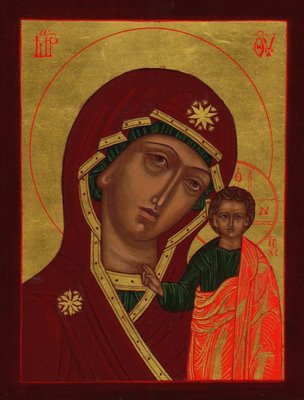
You see here "Our Lady of Kazan" - a painting after one of the most famous Russian Icons. The first original from the 16th century may have been lost. The painter is unknown. It is surely one of the most painted versions of Theotokos-Icons (Icons of Mother Mary). Imagine, there are altogether more than 700 versions and variations of icons of Mother Mary in Orthodox Christianity. Our Lady of Kazan was seen as Mother of the nation (Russia) and protector.
The child Jesus is here majestically in the guesture of teaching, while Mother Mary looks at you.
To read more on this icon please see:
http://en.wikipedia.org/wiki/Our_Lady_of_Kazan
Thursday, August 24, 2006
St. Christopher - the Christ-bearer

The legend about St. Christopher (Christ-bearer) you find at: http://www.catholic-forum.com/saintS/saintc05.htm and at: http://en.wikipedia.org/wiki/Saint_Christopher
 The icon may remind us, that we are all Christ-bearers, as Christ is living within us!
The icon may remind us, that we are all Christ-bearers, as Christ is living within us!Saturday, June 17, 2006
Archangel Gabriel pointing to Christ

Saturday, May 20, 2006
Christ and the animals

All the animals and plants are in harmony with each other, joyfully drawn and concentrated on Jesus like on a magnet. A bird is nearly touching his hand and a fish nearly touching his left foot, whereas Christ is touching the water - where the fishes live in - and the air, where the birds live in.
Christ is standing there - a totally free man - in the guesture of teaching and at the same time gives His blessings to the creatures. It is the garden of Eden.
Holy Trinity: Unity in Diversity

This icon was taken from the famous "Trinity" of Andrej Rubljew, which is valued as one of the most famous icons. It shows the Holy Trinity (Father, Son and Holy Spirit) in persons, and at the same time in an abstract expression. All are same age - or said better: they are ageless - and looking very similar, and all have a rod in hand, which symbolises majesty. The difference is shown by gesture only. There is much symmetry in this icon. It is of the main form of a circle, and if you look closer you may discover more symmetrical forms. The icon is also full of symbolics, which may not be understood without explanation.
The background of this icon is the event in the Old Testament where God reveals Himself to Abraham in the three persons. (Gen 18,1-5) The left side shows the Father, who points to the Son. The Son in the middle looks in obedience to the Father and points to the communion cup. At the right side is the Holy Spirit, who points to the rectangular thing in the table, which symbolises the world. It describes the belief on Christ as the saviour of the world in obedience to the Father and in the love and wisdom of the Holy Spirit. But the general theme is just unity in diversity.
Thursday, May 18, 2006
St. Therese of Lisieux
Friday, April 28, 2006
St. John of the Cross

This icon shows St. John of the Cross (1542-1591), a famous Spain mystic, teacher and poet. Together with St. Therese of Aviala he reformed the monastery of the Carmelitans back to old strictness and concentration. But most of all he was a big self-reformer.
The reform of monastical life did not only find friends, but his old order wanted that he should give up and return. As he objected he was imprisoned in the monastery in Toledo in a small windowless room for 9 months. Here in this darkness of the room and likewise of his soul he found unexpectedly the bright shining light of Divine Love lightening up from within with a force never experienced so far. It flowed over in spiritual love-poetry, which is famous until today.
The icon shows St. John of the Cross with pencil. The voice speaking is the Higher Power symbolized in the hand of God. The written sentence is from the "Spiritual Cantical", verse 28:
My soul is occupied,
And all my substance in His service;
Now I guard no flock,
Nor have I any other employment:
My sole occupation is love.
For those interested in more on St.John, see at: http://www.newadvent.org/cathen/08480a.htm http://en.wikipedia.org/wiki/John_of_the_Cross
Friday, April 21, 2006
Narada II

"It [Bhakti] is indeed of the nature of intense love towards HIM".
For more please have a look at:
http://narada-bhakti-sutras.blogspot.com/2005/05/sutra-2-pull-from-within.html
Monday, April 17, 2006
"Do not cling to me!"

This icon is according to a much moving story from the New Testament. It was after Jesus has died on the cross and was burried. Mary of Magdala came to the tomb, but did not find the corpse there. She wept bitterly as she thought, someone has brought the corpse of Jesus away. Then Jesus appeared to her as a gardener and showed her this way, that he was alife, and only the body has gone. At first she did not realize that the gardener was Jesus - but when she realized she called out: "Rabboni!" This means "teacher" in Hebrew. Jesus replied: "Do not cling to me!"(see Joh. 20)
Sunday, April 16, 2006
Easter Icon
Friday, April 14, 2006
Thursday, April 13, 2006
Monday, April 10, 2006
Saturday, April 08, 2006
Christ's Entry into Jerusalem
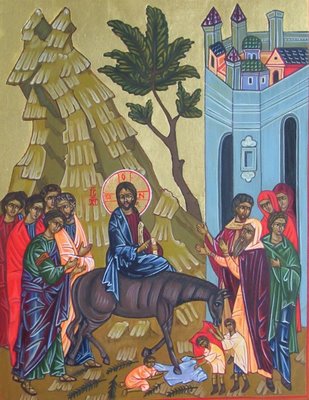
When Jesus entered Jerusalem, people were full of praise:
"Then many spread their outer garments to carpet the road, and others leafy branches which they had cut down in the fields; while those who led the way and those who followed kept shouting "God save Him!" Blessed be He who comes in the Lord's name. Blessings on the coming Kingdom of our forefather David! God in the highest Heavens save Him!" (Mk, 11, 8-10)
Some days later He was killed there and surely some of those who had praised Him earlier now abused him. Such lots of praise and blemish within such a short time!
Thursday, April 06, 2006
The Theotokos of the Passion
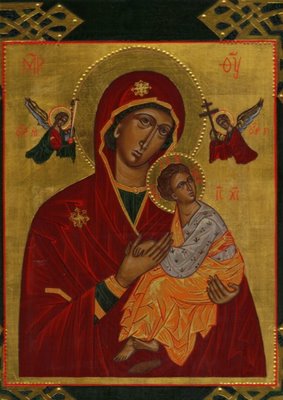
Saturday, April 01, 2006
St. George and the dragon

About the legend of St. George and the dragon you can read at: http://www.shcsc.k12.in.us/arthur/stgeorg.htm
The dragon is the ego - and our task is to take off its power. One powerful means for this is surrender.
Wednesday, March 29, 2006
"I am the vine, you are the branches"
I am the Vine, you are the branches. He who continues in me and in whom I continue bears abundant fruit, for apart from me you can do nothing."
"If any one does not continue in me, he is like the unfruitful branch which is at once thrown away and then withers up. Such branches they gather up and throw into the fire and they are burned."
The icon shows Christ as the vine: The branches are born out of the side of Jesus, who sits on the altar (a reference to the last supper), and it is Jesus himself who harvest the fruit. So all takes place in Him. He is the source and likewise the fulfillment for the fruit.
Tuesday, March 28, 2006
Narada, the celestial musician, detail

Sri Narada sings:
"But Narada is of the opinion that the essential characteristics of Bhakti are the consecration of all activities, by complete self-surrender to Him [God], and extreme anguish if He were to be forgotten." (Narada Bhakti Sutras, v. 19)
see also at: http://www.narada-bhakti-sutras.blogspot.com/
Narada, the celestial musician

Sri Narada is said to be the celestial musician, wandering through heaven, earth and even hell as He pleases, playing the vina and singing God's praise. The whole nature - animals, trees, flowers ... are listening and all are in union and harmony. Where Narada touches the earth a lotus flower is blooming.
Saturday, March 25, 2006
The Storm on the Sea

Tuesday, March 21, 2006
Christ the Centre, detail
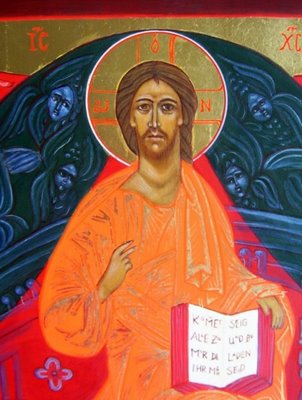
Here is the detail:
The New Testament is opened at Mt 11,28:
"Come to me, all you toiling and burdened ones, and I will give you rest."
The first part of this verse is written in German language.
The look of Christ is mild and compassionate. He holds his right hand in the teacher guesture but likewise in blessing.
Christ the Centre

This Icon-painting I would like to call "Christ the Centre". The eternal sphere in blue with the seraphim (angels) penetrates the world-sphere - or perhaps more correctly said: The world is based on eternity. In the four edges you see the symbols of the 4 evangelists. Christ sits majestetically enthroned in the Centre - all leads to Him.
Christ wears a robe wich is interwoven with gold - gold is the symbol of eternity - the eternal Self. Likewise all is based / surrounded with gold - all takes place in eternity.
The painting was created according to an Icon of Andrew Rubljow, the famous Russian Icon painter, who lived in the 14./15th. century.




















